by R. John Howe
Dear folks -
On September 8, 2007, Jerry Thompson hosted a “rug morning”
at The Textile Museum here in Washington, D.C. on the subject of
“Potpourri: Carpets from the Middle East.”.

Daniel Walker, the TM’s Director, introduced Jerry, noting that
Jerry has been doing rug mornings for over 30 years.

Jerry
explained the “potpourri” approach to a rug morning.

He said that a good analog is the event
at a carnival or county fair where a person guesses you age and weight,
within narrow limits, from your physical appearance. In this
“rug potpourri” Jerry said, it would be his task to make a
first attempt at suggesting where a given piece was likely woven.
The audience was invited to disagree or supplement Jerry’s
indications.
Jerry also invited questions. His practice, he added, would be to answer those that he could, commenting, as he did so, on their sagacity, but to suggest that any that he could not answer were simply inappropriate questions. :-)
Jerry brought some pieces and a number of additional interesting things were brought in by participants. With two exceptions, I can show you only pieces that belong to Jerry, since I don’t have permission to put the others up on the internet.
I was a little late for this session and so was sitting back a bit and the photos I took mostly suffer from the distance at which they were taken. Rugs soak up light and tend to be darker and reveal less of their designs at a distance. Still there are things here likely worth sharing.
One piece brought in by participants, that I have permission to show you, is this very unusual Afshar bag below.
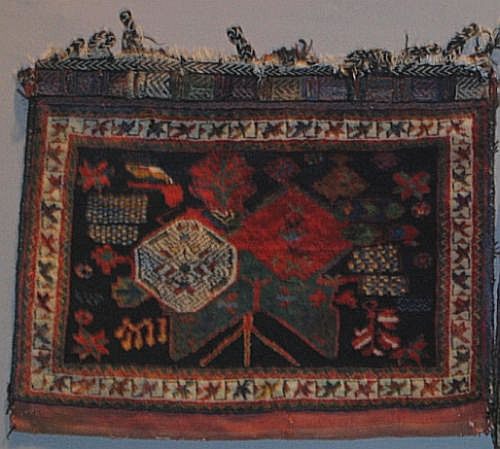
Jerry’s second piece was a Turkmen kalyk, a rarish format.

Kalyks are wedding decorations used in the front of the bridal camel or litter. Most seem attributed to the Tekke. Jerry said that this one was once offered to the TM, but that the TM had declined to accept since they felt they had a better one. The result of that refusal is that it came Jerry’s way. (Again, the details of the design on this piece do not come through in this image. Jourdan’s Plate 91 is similar.)
The next piece was also Tekke Turkmen and also on the rare side.

Jerry also invited questions. His practice, he added, would be to answer those that he could, commenting, as he did so, on their sagacity, but to suggest that any that he could not answer were simply inappropriate questions. :-)
Jerry brought some pieces and a number of additional interesting things were brought in by participants. With two exceptions, I can show you only pieces that belong to Jerry, since I don’t have permission to put the others up on the internet.
I was a little late for this session and so was sitting back a bit and the photos I took mostly suffer from the distance at which they were taken. Rugs soak up light and tend to be darker and reveal less of their designs at a distance. Still there are things here likely worth sharing.
One piece brought in by participants, that I have permission to show you, is this very unusual Afshar bag below.

Jerry’s Afshar attribution was not
debated and the audience joined him in saying that they could not
remember something similar. Here’s a little closer image.
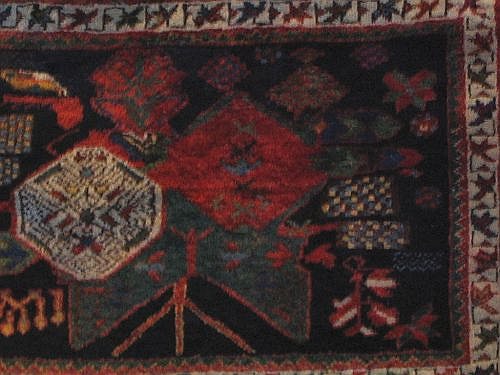
As I indicated above, such a piece soaks up light and these two images do not do it justice. But you can see the playful asymmetry that it displays.
The first of Jerry’s pieces is the Luri bag face below.
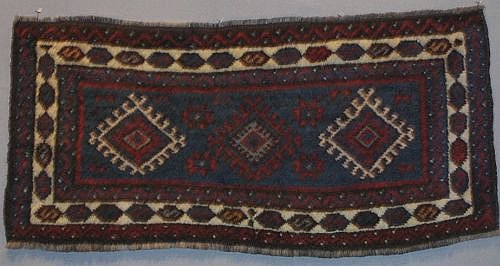
It has silky wool. Gordon Priest suggested from the audience that it is likely the side panel of a mafrash-type cargo bag.

As I indicated above, such a piece soaks up light and these two images do not do it justice. But you can see the playful asymmetry that it displays.
The first of Jerry’s pieces is the Luri bag face below.

It has silky wool. Gordon Priest suggested from the audience that it is likely the side panel of a mafrash-type cargo bag.
Jerry’s second piece was a Turkmen kalyk, a rarish format.

Kalyks are wedding decorations used in the front of the bridal camel or litter. Most seem attributed to the Tekke. Jerry said that this one was once offered to the TM, but that the TM had declined to accept since they felt they had a better one. The result of that refusal is that it came Jerry’s way. (Again, the details of the design on this piece do not come through in this image. Jourdan’s Plate 91 is similar.)
The next piece was also Tekke Turkmen and also on the rare side.

This torba is unusual in that its field has three full and six half
guls, something that occurs infrequently in Turkmen rugs in general,
but that is seen most often on Salor, Saryk and Tekke pieces with large
turreted “Salor” guls. It also occurs on some
Arabatchi bags with chuval guls. Such a Tekke usage on a torba
with the larger torba guls is pretty rare.
The next piece is the second brought in by an audience member. It is a small Tekke rug that he inherited recently.
The next piece is the second brought in by an audience member. It is a small Tekke rug that he inherited recently.

This piece resembles some smaller sized
Tekke pieces that occur in great numbers and that we often call
“wedding rugs.” This one has the small white ground
border stripe on both ends that some think is a Soviet era indicator.
Jerry’s next piece was this small, squarish mat.
Jerry’s next piece was this small, squarish mat.

Jerry acknowledged that this piece is
darker than those he usually likes and that he especially wishes that
it had a white-ground border. Its primary aspect of interest is
its Bidjar structure.
Jerry next put up a colorful Balouch piece.
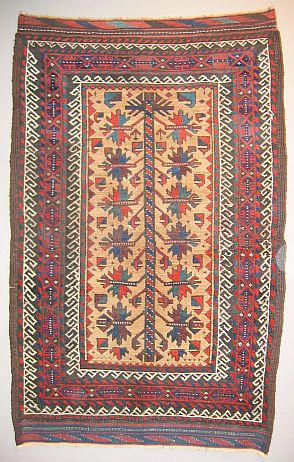
Jerry next put up a colorful Balouch piece.

Someone in the audience asked for good
photos of this piece, so I put it up again after Jerry’s session
and took several. So I can show you more and better images of it.
A corner up close.

A corner up close.

A closer view of the field.

A closer border detail.
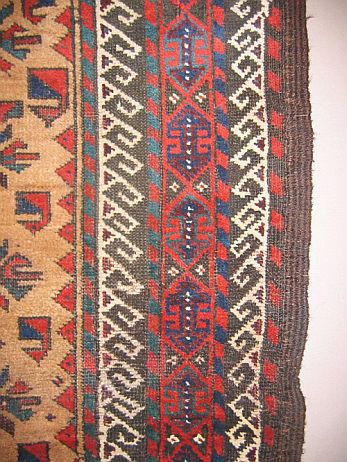
And a section of the back.
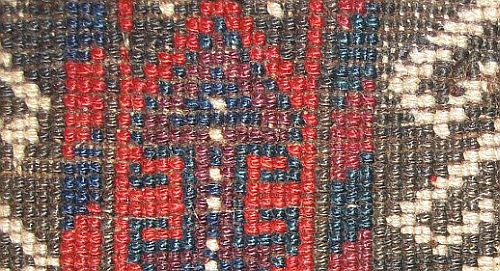
Notice that there are a number of single knot nodes visible, a sign of deep warp depression.
Jerry also had this large Bakhtiari bag with a lighter palette.



Notice that there are a number of single knot nodes visible, a sign of deep warp depression.
Jerry also had this large Bakhtiari bag with a lighter palette.

He said that at least four different weaving techniques were used in it.
Jerry had a last piece that he introduced by acknowledging that it is a rather dramatic departure from both his own and more generally held standards of what might be seen as “collectible.” He said that he wanted a few minutes of explanation before the hooting began. :-)
Jerry had a last piece that he introduced by acknowledging that it is a rather dramatic departure from both his own and more generally held standards of what might be seen as “collectible.” He said that he wanted a few minutes of explanation before the hooting began. :-)
Here is Jerry last rug.

He said that it is Chinese, perhaps
about 1920, with a garish palette of pretty obviously synthetic dyes,
but that its graphics still have appeal for him.


So much so that he has actually had a little restoration work done on it.
I asked to see the back and he was a good sport about that.

I asked to see the back and he was a good sport about that.

Michael Seidman commented from the
audience that there are Chinese art deco pieces, but that the palette
of this piece, especially its black-brown ground color is a real
departure from the usual.
I said to Jerry after, that he should not feel self-conscious about buying something that he likes that is a departure from usual standards. Otherwise, it is not his collection.
I am sorry not to be able to show you some of the other remarkable material brought in for this session, but I hope you will agree that something above is interesting and enjoyable.
Regards,
R. John Howe
I said to Jerry after, that he should not feel self-conscious about buying something that he likes that is a departure from usual standards. Otherwise, it is not his collection.
I am sorry not to be able to show you some of the other remarkable material brought in for this session, but I hope you will agree that something above is interesting and enjoyable.
Regards,
R. John Howe